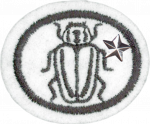Difference between revisions of "AY Honors/Insects - Advanced/Answer Key/es"
(Created page with "</noinclude>") |
(Created page with "</noinclude>") |
||
| Line 202: | Line 202: | ||
{{ansreq|page={{#titleparts:{{PAGENAME}}|2|1}}|num=9c}} <!--T:40--> | {{ansreq|page={{#titleparts:{{PAGENAME}}|2|1}}|num=9c}} <!--T:40--> | ||
<noinclude></noinclude> | <noinclude></noinclude> | ||
| − | |||
'''''The Ant and the Grasshopper''''' is one of Aesop's fables drawing upon this difference. | '''''The Ant and the Grasshopper''''' is one of Aesop's fables drawing upon this difference. | ||
Revision as of 20:39, 25 February 2021
| Insectos - Avanzado | ||
|---|---|---|
| Asociación General
|
Destreza: 2 Año de introducción: 1949 |
|
Requisitos
|
La especialidad de Insectos - Avanzado es un componente de la Maestría Naturaleza. |
|
La especialidad de Insectos - Avanzado es un componente de la Maestría Zoología. |
1
Para consejos e instrucciones, véase Insectos.
2
- a. Añadir a su colección 50 especies de insectos que representen al menos 10 diferentes órdenes. Las etiquetas deben incluir el nombre del colector, fecha, localidad, el orden, la familia, género y nivel de especie o nombre. (Especímenes montados con descuido y rotas no serán aceptables).
- b. Añadir a sus dibujos a color o pinturas 50 especies de insectos que representen al menos 10 diferentes órdenes. Dibujos o pinturas deben ser del tamaño real o más grande, para mostrar los detalles de los pequeños insectos, y en colores naturales. Colocar una etiqueta a los dibujos con la fecha, orden, familia, género y el nombre del nivel de especie.
- c. Añadir a sus imágenes de color 50 especies de insectos que representen al menos 10 diferentes órdenes. Todas las imágenes deben estar enfocadas, en primer plano y debidamente etiquetadas, indicando dónde fue fotografiado, fecha de la fotografía, nombres comunes y cada género o nombre del nivel de especie.
3
4
Bees
Eggs are laid singly in a cell in a wax honeycomb, produced and shaped by the worker bees. Larvae are initially fed with royal jelly produced by worker bees, later switching to honey and pollen. The exception is a larva fed solely on royal jelly, which will develop into a queen bee. The larva undergoes several moltings before spinning a cocoon within the cell, and pupating. Drones hatch from unfertilized eggs, females (Queens and worker bees) hatch from fertilized eggs. The queen actually can choose to fertilize the egg she is laying, usually depending on what cell she is laying in.
5
Social insects, such as the termites, ants and many bees and wasps, live together in large well-organized colonies that may be so tightly integrated and genetically similar that the colonies of some species are sometimes considered superorganisms.
6
| Mosquito | Flea | Louse | Housefly | Tsetse fly |
|---|---|---|---|---|
|
|
|
|
|
7
7a
7b
7c
8
An easy way to trap night-flying insects is to suspend a white bedsheet vertically next to a light bulb. Be careful that the bulb does not touch the sheet, as this would be a fire hazard. If possible, use a light bulb that emits ultra-violet light (but be careful to not look at the lit bulb as it can cause eye damage). The insects will be attracted to the light and land on the sheet. They can be picked off by hand.
9
9a
i
ii
iii
iv
v
vi
9b
9c
The Ant and the Grasshopper is one of Aesop's fables drawing upon this difference. The fable concerns a grasshopper who has spent the warm months singing away while the ant (or ants in some editions) worked to store up food for winter. After the winter has come, the grasshopper finds itself dying of hunger, and upon asking the ant for food is only rebuked for its idleness. The story is used to teach the virtues of hard work and saving, and the perils of improvidence. Some versions of the fable state a moral at the end, along the lines of:
- Idleness brings want
- To work today is to eat tomorrow
- It is best to prepare for the days of necessity
References
- Categoría: Tiene imagen de insignia
- Adventist Youth Honors Answer Book/Honors/es
- Adventist Youth Honors Answer Book/es
- Adventist Youth Honors Answer Book/Skill Level 2/es
- Categoría: Libro de respuestas de especialidades JA/Especialidades introducidas en 1949
- Adventist Youth Honors Answer Book/General Conference/es
- Adventist Youth Honors Answer Book/Nature/es
- Adventist Youth Honors Answer Book/Nature/Primary/es
- Adventist Youth Honors Answer Book/Stage 0/es
- Adventist Youth Honors Answer Book/Naturalist Master Award/Fauna/es
- Adventist Youth Honors Answer Book/Zoology Master Award/Fauna/es
- AY Honors/Prerequisite/Insects/es
- AY Honors/See Also/Insects/es
- Adventist Youth Honors Answer Book

